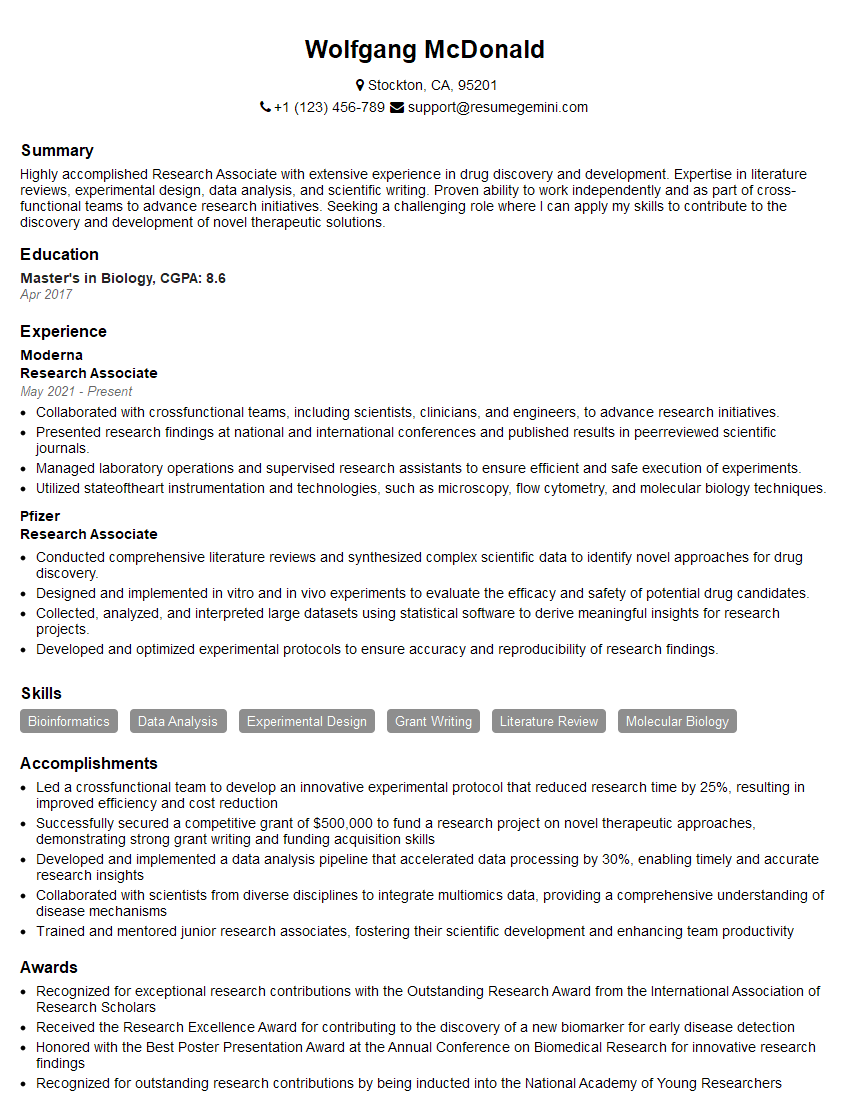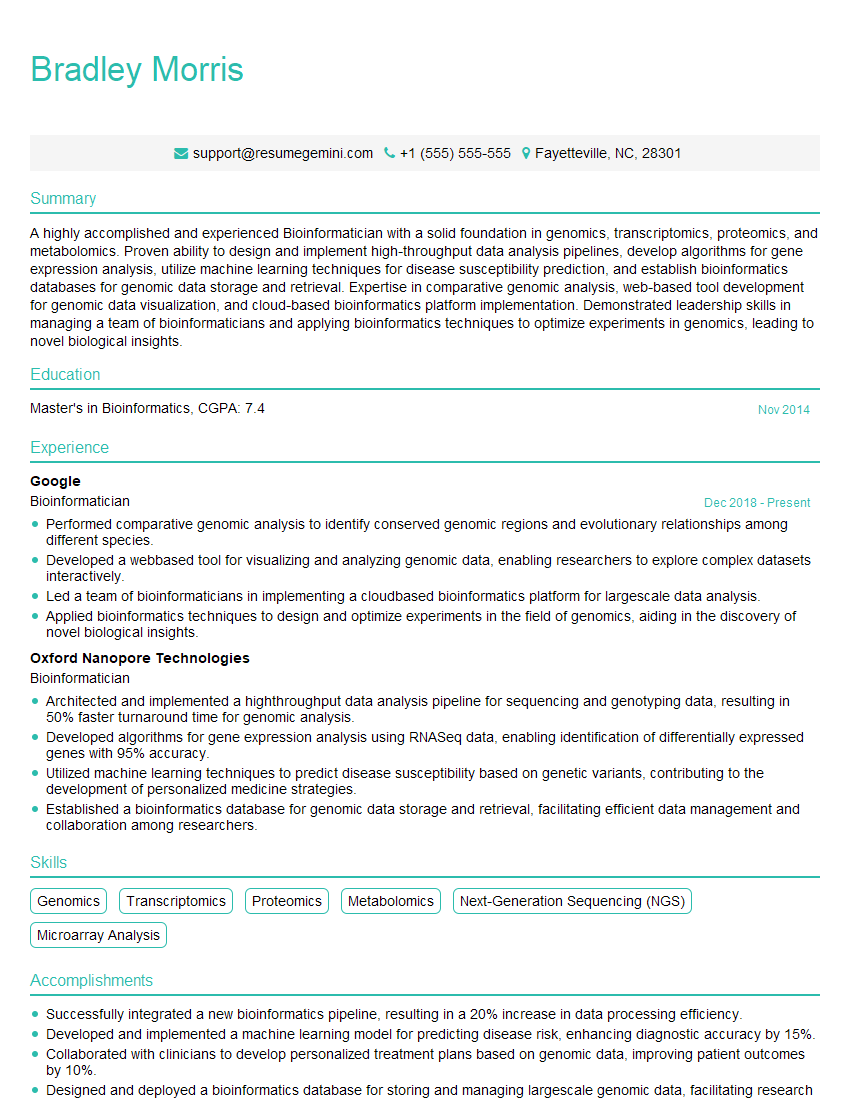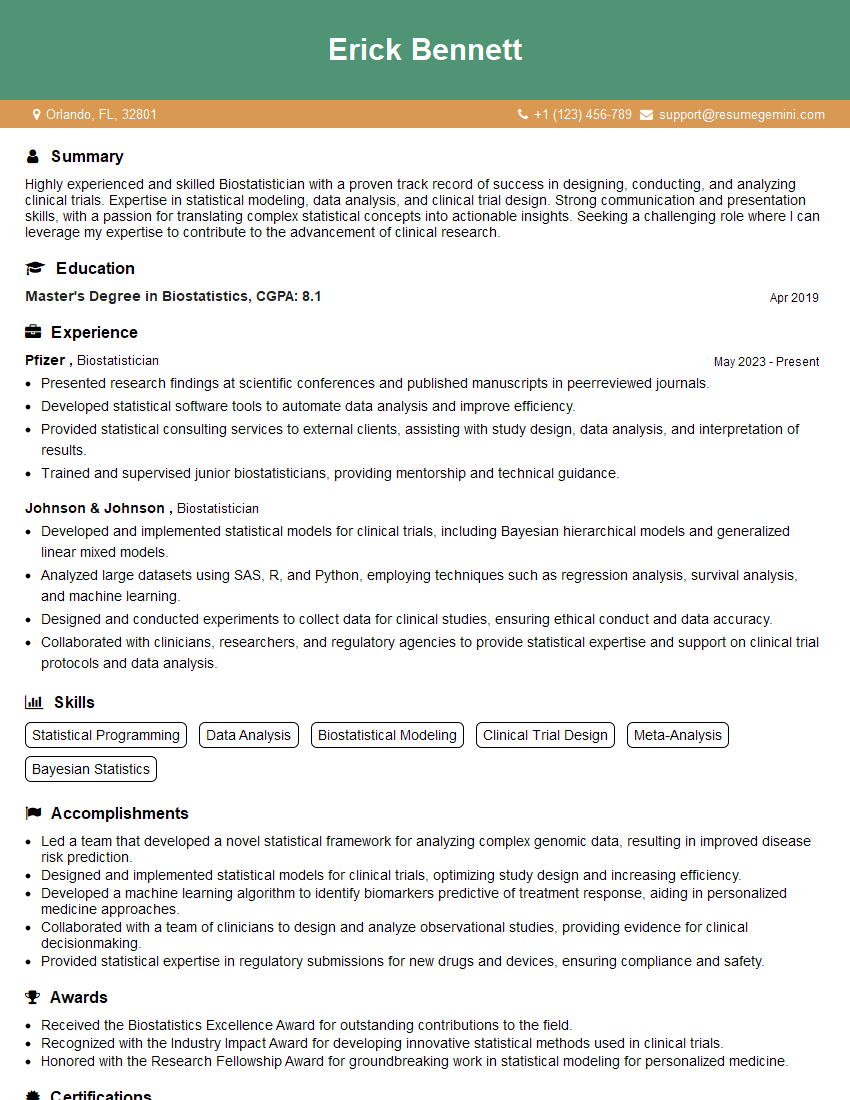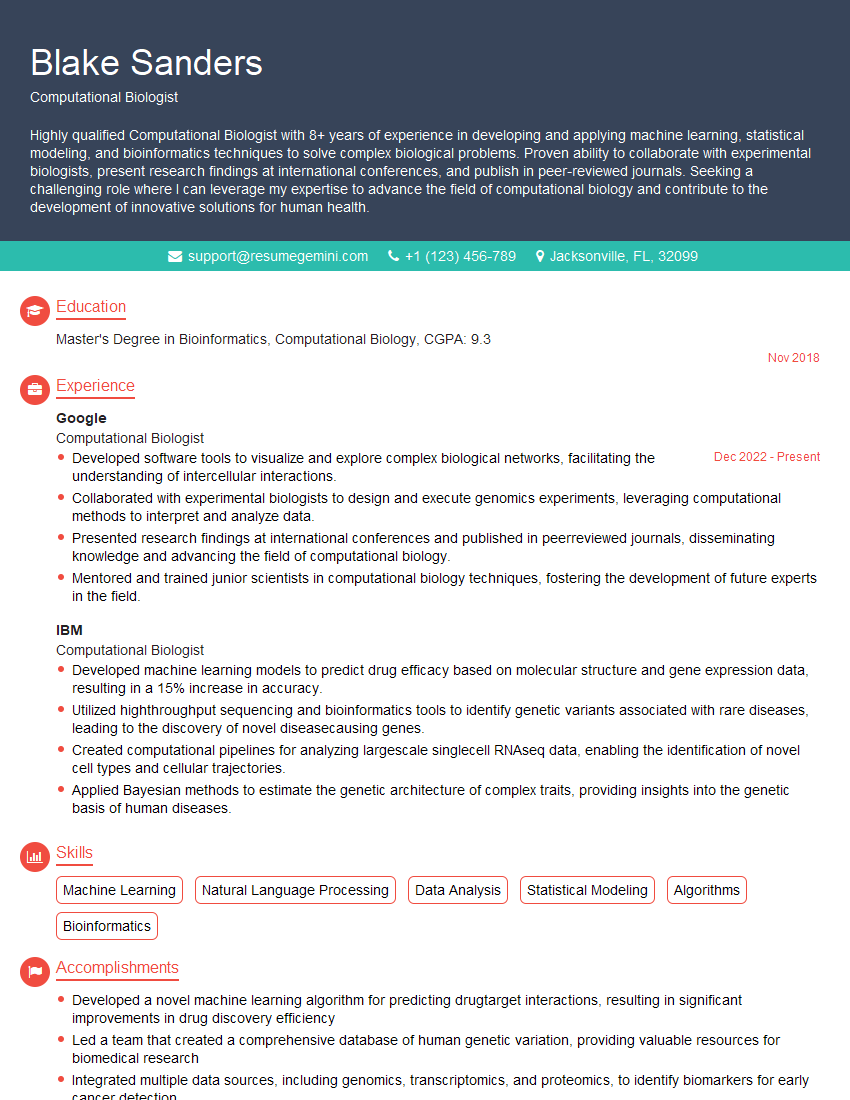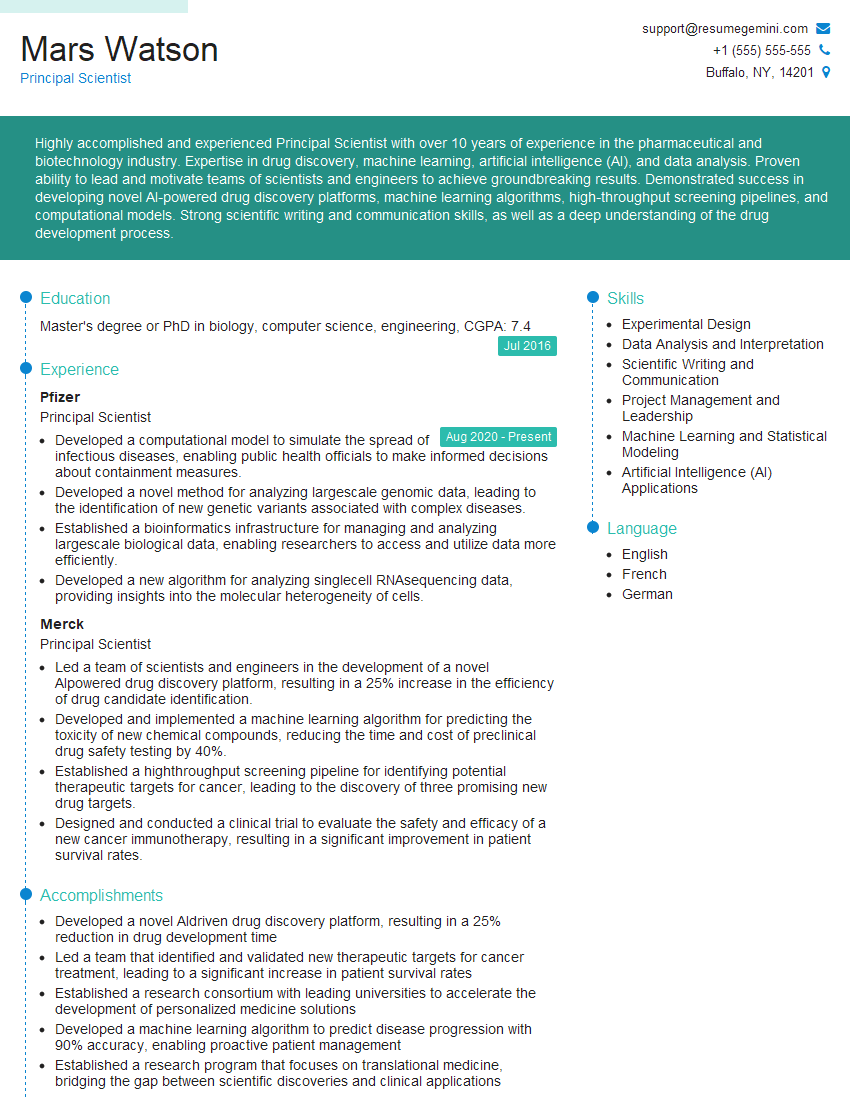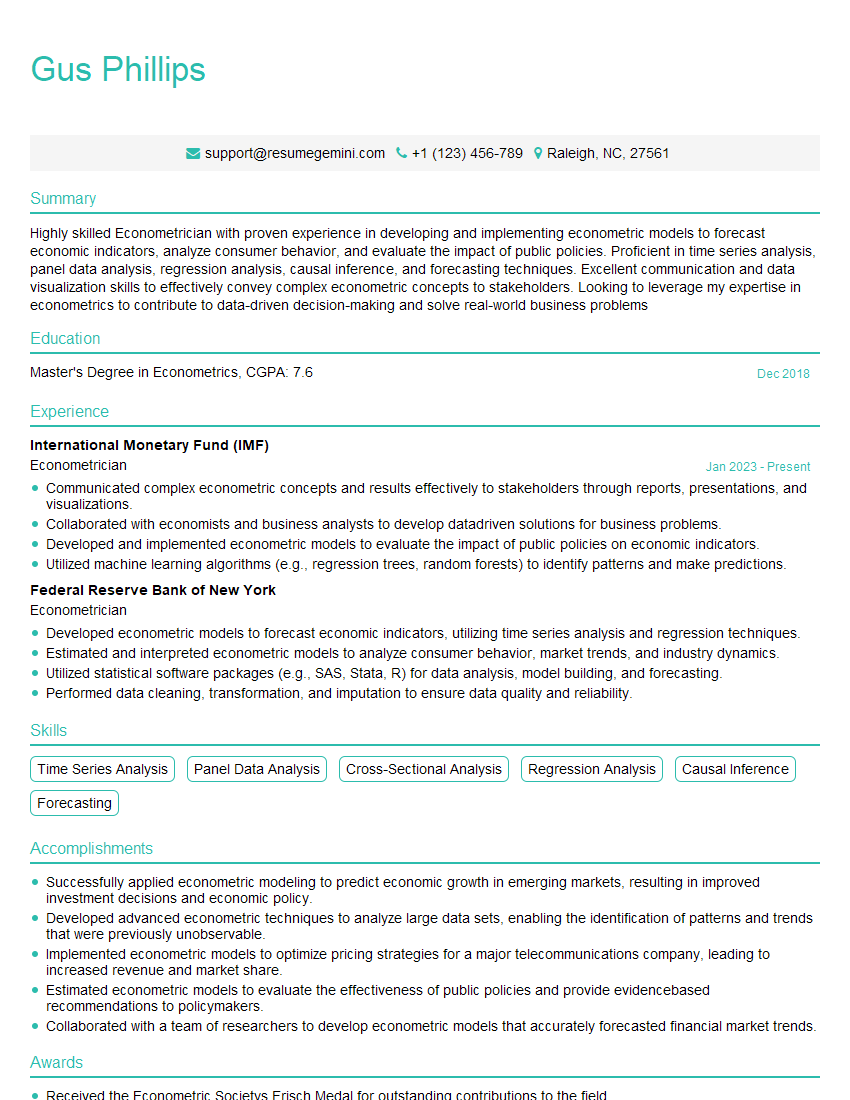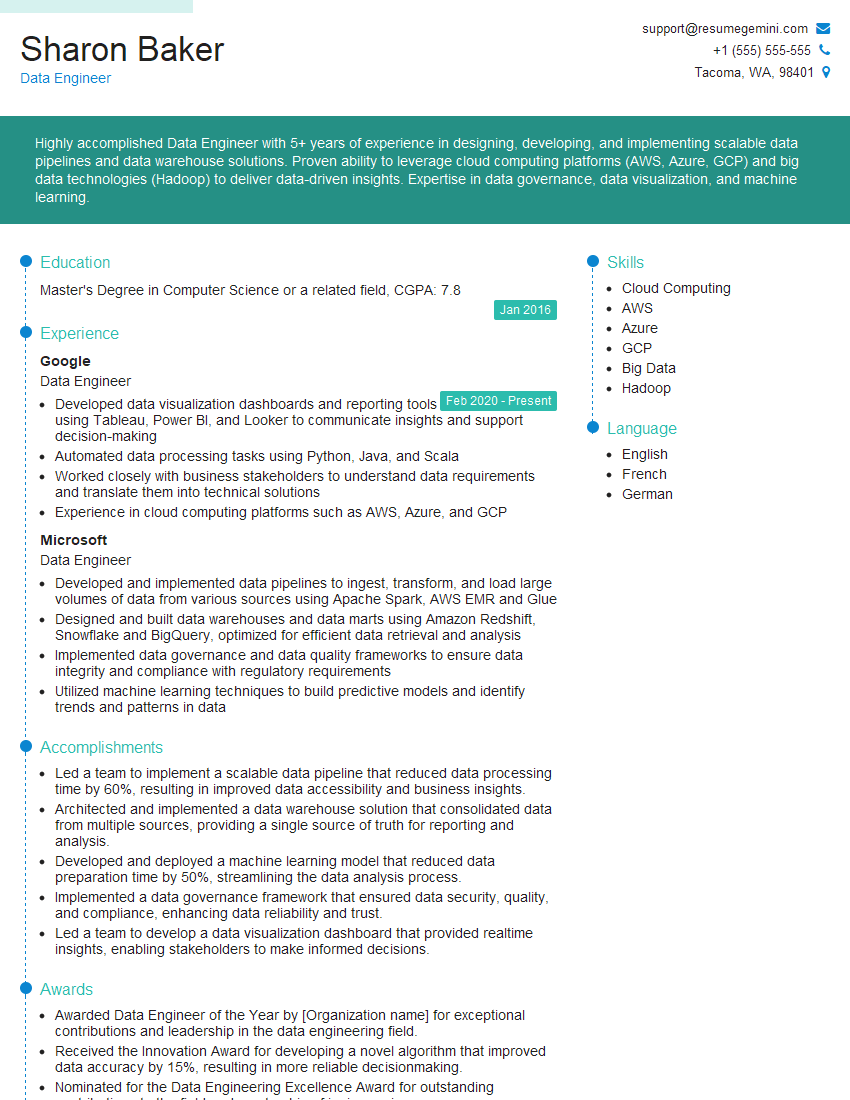Interviews are more than just a Q&A session—they’re a chance to prove your worth. This blog dives into essential Scientific Data Analysis interview questions and expert tips to help you align your answers with what hiring managers are looking for. Start preparing to shine!
Questions Asked in Scientific Data Analysis Interview
Q 1. Explain the difference between correlation and causation.
Correlation and causation are two distinct concepts in statistics. Correlation simply measures the strength and direction of a relationship between two variables. Causation, on the other hand, implies that one variable directly influences or causes a change in another. Just because two variables are correlated doesn’t mean one causes the other.
Example: Ice cream sales and crime rates might be positively correlated – both tend to increase during the summer. However, this doesn’t mean that eating ice cream causes crime. The underlying factor, the hot weather, influences both.
Confounding variables are a common reason for spurious correlation. These are hidden factors influencing both variables, creating a false impression of a direct causal link. To establish causation, we usually need controlled experiments or strong evidence from observational studies that account for potential confounders.
Q 2. Describe your experience with different data visualization techniques.
My experience with data visualization encompasses a wide range of techniques, tailored to different data types and analytical goals. I’m proficient in using static visualizations like:
- Scatter plots: Ideal for showing the relationship between two continuous variables. For example, visualizing the correlation between advertising spend and sales.
- Bar charts: Excellent for comparing categorical data, such as sales across different product categories.
- Histograms: Show the distribution of a single continuous variable, like customer ages or product prices.
- Box plots: Useful for comparing the distribution of a variable across different groups, such as comparing the income distribution of different demographics.
Beyond static visualizations, I also have experience with interactive visualizations using tools like Tableau and Power BI, allowing for dynamic exploration and deeper insights. For instance, I’ve used interactive dashboards to allow users to filter data by various parameters and explore trends over time.
The choice of visualization technique always depends on the specific data and the story I’m trying to tell. A clear, concise, and easily understandable visualization is paramount, prioritizing clarity over complexity.
Q 3. What are the key assumptions of linear regression?
Linear regression models assume several key conditions for accurate and reliable results:
- Linearity: The relationship between the independent and dependent variables should be linear. This means a straight line can reasonably approximate the relationship.
- Independence: Observations should be independent of each other. This is violated, for example, if you have repeated measurements on the same subject without accounting for it.
- Homoscedasticity: The variance of the errors (residuals) should be constant across all levels of the independent variable. Heteroscedasticity (non-constant variance) violates this assumption.
- Normality: The errors (residuals) should be normally distributed. While slight deviations can be tolerated, severe departures can affect the reliability of inferences.
- No multicollinearity: In multiple linear regression, predictor variables should not be highly correlated with each other. High multicollinearity can inflate standard errors and make it difficult to interpret the individual effects of predictors.
Violation of these assumptions can lead to inaccurate parameter estimates, unreliable p-values, and invalid conclusions. Diagnostic plots like residual plots and Q-Q plots are essential for assessing the validity of these assumptions.
Q 4. How do you handle missing data in a dataset?
Handling missing data is a crucial step in data analysis. Ignoring missing values can lead to biased results. The best approach depends on the nature and extent of the missing data, as well as the characteristics of the dataset.
Common strategies include:
- Deletion: Removing rows or columns with missing values (Listwise or Pairwise deletion). This is simple but can lead to significant information loss if many values are missing.
- Imputation: Replacing missing values with estimated values. Methods include:
- Mean/Median/Mode imputation: Replacing missing values with the mean, median, or mode of the observed values. Simple but can distort the distribution.
- Regression imputation: Predicting missing values using a regression model based on other variables. More sophisticated but assumes a relationship exists.
- K-Nearest Neighbors (KNN) imputation: Uses the values of the k nearest neighbors to estimate the missing value. Useful for non-linear relationships.
- Multiple imputation: Creates multiple plausible imputed datasets and combines the results to account for uncertainty in imputation.
The choice of method requires careful consideration. For example, if missingness is random (MCAR), simple imputation methods might suffice. If missingness depends on the value of the variable (MAR), more sophisticated techniques like multiple imputation are preferable. Understanding the mechanism of missingness (Missing Completely at Random (MCAR), Missing at Random (MAR), Missing Not at Random (MNAR)) is crucial for choosing the right approach.
Q 5. Explain different methods for feature scaling.
Feature scaling transforms the range of numerical features to a standard scale, improving the performance of many machine learning algorithms. Common methods include:
- Min-Max scaling (Normalization): Scales features to a range between 0 and 1. The formula is:
x_scaled = (x - x_min) / (x_max - x_min) - Standardization (Z-score normalization): Scales features to have a mean of 0 and a standard deviation of 1. The formula is:
x_scaled = (x - x_mean) / x_std - Robust scaling: Uses the median and interquartile range (IQR) instead of mean and standard deviation, making it less sensitive to outliers.
The choice between these methods depends on the algorithm and the data distribution. For algorithms sensitive to feature scaling, like k-Nearest Neighbors or Support Vector Machines, standardization is often preferred. Min-Max scaling is suitable when the range of values is important. Robust scaling is a good option when dealing with datasets containing outliers.
Q 6. Describe your experience with different data mining techniques.
My experience in data mining involves various techniques, applied across a range of projects. I have utilized techniques like:
- Association rule mining (Apriori algorithm): Used to discover interesting relationships between variables in large datasets, like identifying products frequently purchased together in market basket analysis.
- Clustering (K-means, hierarchical clustering): Used to group similar data points together, for instance segmenting customers based on their purchasing behavior or grouping documents based on their content.
- Classification (Decision trees, Support Vector Machines, Naive Bayes): Used to build models that predict a categorical outcome, such as classifying emails as spam or not spam, or predicting customer churn.
- Regression (Linear Regression, Logistic Regression): Used to predict a continuous outcome, like predicting house prices or customer lifetime value.
I’ve worked on projects ranging from customer segmentation using clustering algorithms to fraud detection using classification models, and always tailor my approach to the specific problem and dataset. The selection of the appropriate data mining technique is guided by understanding the data, the objective, and the limitations of each technique.
Q 7. How do you evaluate the performance of a classification model?
Evaluating a classification model’s performance involves using various metrics, depending on the context and the goals of the analysis. Key metrics include:
- Accuracy: The ratio of correctly classified instances to the total number of instances. While simple, it can be misleading in imbalanced datasets.
- Precision: The proportion of true positives among all instances predicted as positive. Answers the question: Of all the instances predicted positive, what proportion was actually positive?
- Recall (Sensitivity): The proportion of true positives among all actual positive instances. Answers the question: Of all the actual positive instances, what proportion did the model correctly identify?
- F1-score: The harmonic mean of precision and recall, providing a balanced measure of both. Useful when both precision and recall are important.
- ROC curve (Receiver Operating Characteristic curve) and AUC (Area Under the Curve): Visualizes the trade-off between true positive rate and false positive rate at various classification thresholds. AUC represents the overall performance of the classifier.
- Confusion Matrix: A table showing the counts of true positives, true negatives, false positives, and false negatives. Provides a detailed breakdown of the model’s performance.
The choice of metric depends on the specific application. For example, in medical diagnosis, high recall is crucial (avoiding false negatives), while in spam detection, high precision might be prioritized (avoiding false positives). A comprehensive evaluation usually involves multiple metrics and careful consideration of the context.
Q 8. What are the advantages and disadvantages of different machine learning algorithms?
Choosing the right machine learning algorithm depends heavily on the nature of your data and the problem you’re trying to solve. Each algorithm has strengths and weaknesses.
- Linear Regression: Simple, interpretable, fast. Great for predicting continuous variables with a linear relationship. Disadvantage: Assumes linearity, sensitive to outliers.
- Logistic Regression: Predicts probabilities of categorical outcomes. Interpretable, relatively efficient. Disadvantage: Assumes linearity, struggles with non-linear relationships.
- Decision Trees: Easy to understand and visualize, handles non-linear relationships well. Disadvantage: Prone to overfitting, can be unstable.
- Support Vector Machines (SVMs): Effective in high dimensional spaces, versatile with different kernel functions. Disadvantage: Can be computationally expensive for large datasets, choice of kernel is crucial.
- Random Forests: Ensemble method that combines multiple decision trees, reducing overfitting and improving accuracy. Disadvantage: Can be less interpretable than single decision trees, computationally more intensive.
- Neural Networks: Powerful for complex patterns, can model non-linear relationships effectively. Disadvantage: Requires significant data, computationally expensive, requires expertise to tune hyperparameters.
- K-Nearest Neighbors (KNN): Simple, non-parametric, easy to implement. Disadvantage: Computationally expensive for large datasets, sensitive to irrelevant features, requires careful choice of distance metric.
For instance, I once used linear regression to predict house prices based on size and location. The simplicity and interpretability were key, as the stakeholders needed to understand the factors driving the predictions. In another project, a neural network was necessary to classify complex images, where the patterns were highly non-linear and intricate.
Q 9. Explain the concept of overfitting and underfitting.
Overfitting and underfitting are common problems in machine learning that describe how well a model generalizes to unseen data. Imagine trying to fit a curve to a set of data points.
Overfitting: The model learns the training data *too* well, including the noise and outliers. It performs excellently on the training data but poorly on new, unseen data. Think of it as memorizing the training data instead of learning the underlying patterns. The curve fits the training points perfectly, but is overly complex and wiggly, failing to capture the true trend.
Underfitting: The model is too simple to capture the underlying patterns in the data. It performs poorly on both the training and test data. The curve is a straight line that doesn’t capture the overall trend of the data points.
Techniques to mitigate these issues include cross-validation, regularization (e.g., L1 and L2), feature selection, and using simpler models when appropriate.
Q 10. How do you select appropriate evaluation metrics for a given problem?
The choice of evaluation metrics depends entirely on the problem type and business objectives. There’s no one-size-fits-all answer.
- Classification: Accuracy, precision, recall, F1-score, AUC-ROC are commonly used. For imbalanced datasets, F1-score or AUC-ROC are often preferred over accuracy. The choice depends on whether minimizing false positives or false negatives is more important.
- Regression: Mean Squared Error (MSE), Root Mean Squared Error (RMSE), Mean Absolute Error (MAE), R-squared are common choices. MSE and RMSE penalize larger errors more heavily. R-squared measures the goodness of fit. The choice depends on the context and the importance of the scale of errors.
- Clustering: Silhouette score, Davies-Bouldin index, Calinski-Harabasz index are used to evaluate the quality of clusters. These metrics consider both the compactness within clusters and the separation between clusters.
For example, in a fraud detection system (classification), recall is crucial; we want to minimize false negatives (missing fraudulent transactions), even if it means more false positives (flagging legitimate transactions). In predicting house prices (regression), RMSE might be suitable as it gives a direct measure of the average prediction error in the same units as the target variable.
Q 11. Describe your experience with statistical hypothesis testing.
Statistical hypothesis testing is fundamental to drawing valid conclusions from data. It involves formulating a null hypothesis (e.g., there’s no difference between two groups) and an alternative hypothesis (e.g., there is a difference), then using statistical tests (e.g., t-test, ANOVA, chi-squared test) to determine whether there’s enough evidence to reject the null hypothesis.
I have extensive experience with various tests, including t-tests for comparing means of two groups, ANOVA for comparing means of multiple groups, chi-squared tests for analyzing categorical data, and non-parametric tests like the Mann-Whitney U test for data that doesn’t meet the assumptions of parametric tests.
For example, I once used a two-sample t-test to determine if a new drug was more effective than a placebo in reducing blood pressure. The p-value from the test helped us decide whether to reject the null hypothesis of no difference in effectiveness. Understanding the assumptions of the tests – such as normality and independence of data – is crucial for reliable results.
Q 12. Explain different types of sampling techniques.
Sampling techniques are crucial when dealing with large datasets to reduce computational cost and improve efficiency. The choice of sampling method depends on the characteristics of the data and the research question.
- Simple Random Sampling: Each element has an equal chance of being selected. Easy to implement but may not be representative if the population is heterogeneous.
- Stratified Sampling: The population is divided into strata (subgroups), and a random sample is drawn from each stratum. Ensures representation from all subgroups.
- Cluster Sampling: The population is divided into clusters, and a random sample of clusters is selected. All elements within the selected clusters are included. Efficient for geographically dispersed populations.
- Systematic Sampling: Elements are selected at regular intervals from a list. Simple to implement but can be biased if there’s a pattern in the data.
- Convenience Sampling: Selecting readily available individuals. Prone to bias, not suitable for generalizing to the entire population.
In a recent project involving customer survey data, we used stratified sampling to ensure representation from different demographic groups. This helped us avoid biases that might have arisen from a simple random sample.
Q 13. How do you handle outliers in your data?
Outliers can significantly impact the results of statistical analyses. Handling them requires careful consideration. The approach depends on the cause of the outliers and the context of the analysis.
- Identifying Outliers: Box plots, scatter plots, Z-scores, and Interquartile Range (IQR) methods can help identify potential outliers.
- Handling Outliers:
- Removal: Remove outliers if they are due to errors in data collection or entry. However, this should be done cautiously and with justification, as removing too many data points may lead to biased results.
- Transformation: Transform the data (e.g., using logarithmic or square root transformation) to reduce the impact of outliers. This can stabilize variance and make the data more normally distributed.
- Winsorizing/Trimming: Replace extreme values with less extreme values (Winsorizing) or remove a certain percentage of extreme values from both ends of the distribution (Trimming).
- Robust Methods: Use statistical methods that are less sensitive to outliers, such as median instead of mean, or robust regression techniques.
For example, in a dataset containing income levels, a few individuals with extremely high incomes might be outliers. Instead of removing them, I might use a logarithmic transformation to reduce their impact on the analysis, ensuring that the results are more representative of the overall income distribution.
Q 14. What is the difference between supervised and unsupervised learning?
Supervised and unsupervised learning are two fundamental approaches in machine learning that differ in how they use data.
Supervised Learning: The algorithm learns from labeled data, where each data point is associated with a known outcome or target variable. The goal is to learn a mapping from inputs to outputs so that the algorithm can predict the outcome for new, unseen data. Examples include classification (predicting categories) and regression (predicting continuous values). Think of it as learning with a teacher who provides the correct answers.
Unsupervised Learning: The algorithm learns from unlabeled data, where the target variable is unknown. The goal is to discover patterns, structures, or relationships within the data. Examples include clustering (grouping similar data points), dimensionality reduction (reducing the number of variables), and anomaly detection. Think of it as learning without a teacher, exploring the data to find inherent structure.
I’ve used supervised learning extensively for tasks like predicting customer churn (classification) and sales forecasting (regression). Unsupervised learning has been valuable in customer segmentation (clustering) and identifying interesting patterns in experimental data.
Q 15. Explain your experience with big data technologies such as Hadoop or Spark.
My experience with big data technologies like Hadoop and Spark centers around leveraging their distributed processing capabilities for handling massive datasets that wouldn’t fit in a single machine’s memory. Hadoop’s HDFS (Hadoop Distributed File System) provides a robust, fault-tolerant storage solution, while MapReduce allows for parallel processing of data across a cluster. I’ve used Hadoop for tasks like building large-scale inverted indices for text analysis and performing distributed aggregations on terabyte-sized datasets. Spark, with its in-memory processing capabilities, significantly accelerates iterative algorithms and complex analytics compared to Hadoop’s MapReduce. I’ve employed Spark for real-time data streaming analysis, machine learning model training on vast datasets, and graph processing for network analysis. For example, in a previous role, I used Spark to build a recommendation engine for an e-commerce platform, processing user purchase history and product metadata to generate personalized recommendations.
Specifically, I’m proficient in using PySpark, the Python API for Spark, allowing me to integrate my data analysis workflows seamlessly with existing Python libraries and frameworks. I understand the nuances of data partitioning, job scheduling, and resource management within these systems, crucial for optimizing performance and minimizing cost.
Career Expert Tips:
- Ace those interviews! Prepare effectively by reviewing the Top 50 Most Common Interview Questions on ResumeGemini.
- Navigate your job search with confidence! Explore a wide range of Career Tips on ResumeGemini. Learn about common challenges and recommendations to overcome them.
- Craft the perfect resume! Master the Art of Resume Writing with ResumeGemini’s guide. Showcase your unique qualifications and achievements effectively.
- Don’t miss out on holiday savings! Build your dream resume with ResumeGemini’s ATS optimized templates.
Q 16. Describe your experience with database management systems such as SQL or NoSQL.
My experience with database management systems spans both SQL and NoSQL databases. SQL databases, like PostgreSQL and MySQL, are relational databases ideal for structured data with clearly defined schemas. I’m proficient in writing complex SQL queries for data extraction, transformation, and loading (ETL) processes, handling joins, subqueries, and window functions. For example, I’ve used SQL extensively to create data warehouses for business intelligence reporting, ensuring data integrity and efficient querying.
Conversely, NoSQL databases, such as MongoDB and Cassandra, are better suited for unstructured or semi-structured data, offering flexibility and scalability. I have experience working with NoSQL databases for applications like storing log data, handling real-time event streams, and managing large-scale document repositories. For instance, I utilized MongoDB to store and manage user profile information for a social media application, capitalizing on its flexible schema and efficient document retrieval.
My experience extends to understanding the trade-offs between SQL and NoSQL systems, enabling me to choose the appropriate technology based on project requirements and data characteristics. This includes considering factors like data consistency, scalability, and query complexity.
Q 17. What are your preferred programming languages for data analysis?
My preferred programming languages for data analysis are Python and R. Python’s versatility and extensive ecosystem of libraries make it my go-to language for most tasks. Libraries like Pandas, NumPy, and Scikit-learn provide powerful tools for data manipulation, numerical computation, and machine learning. I frequently use Jupyter Notebooks for interactive data exploration and visualization. For example, I recently used Python to develop a predictive model for customer churn using a variety of machine learning algorithms, leveraging Scikit-learn for model training and evaluation.
R is another powerful language, particularly well-suited for statistical computing and data visualization. Packages like ggplot2 provide exceptional tools for creating publication-quality visualizations. I use R when specific statistical techniques are best implemented within its framework, or when the focus is heavily on statistical modeling and inference.
Q 18. Explain your experience with data wrangling and cleaning.
Data wrangling and cleaning are critical steps in any data analysis workflow. My approach is systematic and involves several key steps. First, I perform exploratory data analysis (EDA) to understand the data’s structure, identify missing values, outliers, and inconsistencies. This often involves using visualization techniques to identify patterns and anomalies. Then, I apply data cleaning techniques like handling missing values (imputation or removal), outlier detection and treatment (trimming, winsorizing, or transformation), and data transformation (scaling, encoding categorical variables). I frequently use regular expressions to clean and standardize textual data. For example, I recently had to clean a dataset containing inconsistent date formats. Using Pandas in Python, I applied regular expressions to standardize the date formats before proceeding with the analysis.
Data quality checks are crucial throughout this process. I write unit tests to verify the correctness of data cleaning operations and ensure that data integrity is maintained. Tools like Pandas profiling can also be very helpful for automated data quality assessments.
Q 19. How do you ensure the reproducibility of your analysis?
Reproducibility is paramount in scientific data analysis. My approach focuses on version control, detailed documentation, and transparent code. I use Git for version control, allowing me to track changes to my code and data over time. My code is well-commented and follows a clear structure, making it easy for others (and myself in the future!) to understand. I document all data preprocessing steps, parameter choices, and analysis decisions in detail. I also utilize tools like Docker to create reproducible environments, ensuring that my analysis can be run on different machines with consistent results. Furthermore, I aim to create modular and reusable code, minimizing redundancy and maximizing reproducibility. Wherever possible, I strive to use open-source tools and libraries, and explicitly document all the software and packages used in the analysis, including their versions.
Q 20. Describe a time when you had to deal with a complex data analysis problem.
In a previous project, I was tasked with analyzing the effectiveness of a new marketing campaign. The data was spread across multiple databases and files, with inconsistencies in formatting and missing data. The initial challenge was integrating these disparate sources. I used SQL queries to extract relevant data from relational databases and Python with Pandas to import and clean data from CSV files and handle inconsistencies in data formats. I carefully addressed missing values using appropriate imputation techniques depending on the variable’s nature and distribution. After cleaning and integrating the datasets, I used statistical methods and data visualization techniques to analyze campaign performance and identify key factors influencing its success or failure. The analysis revealed unexpected insights into customer segments that responded well to specific aspects of the campaign, which ultimately improved future campaign strategies. This involved robust data validation and quality checks throughout the process to ensure that the results were reliable and could inform decision-making.
Q 21. How do you communicate complex technical information to non-technical audiences?
Communicating complex technical information to non-technical audiences requires careful planning and a shift in perspective. I avoid using technical jargon and instead use clear, concise language and analogies. For example, instead of saying “we employed a gradient boosting algorithm,” I might say “we used a sophisticated prediction model that learns from past data to make better predictions.” I also utilize visualizations, such as charts and graphs, to illustrate key findings and patterns in the data. Storytelling is a powerful tool; I present findings as narratives, focusing on the implications of the data rather than the technical details of the analysis. Finally, I ensure the presentation is tailored to the audience’s knowledge level and interests, and I’m always prepared to answer questions in a simple and accessible manner. I believe that effective communication is as important as the analysis itself, as it ensures the insights derived from the data are actionable and contribute to informed decision-making.
Q 22. What are some common pitfalls in data analysis?
Common pitfalls in data analysis often stem from overlooking crucial steps in the process. These can be broadly categorized into data quality issues, flawed analysis methods, and misinterpretations of results.
Data Quality Issues: These include missing values, outliers, inconsistencies in data entry, and inaccurate data collection methods. Imagine analyzing customer survey data where many responses are incomplete or contain typos; this directly impacts the validity of your conclusions. Handling missing data improperly (e.g., simply removing rows) can introduce bias.
Flawed Analysis Methods: Choosing the wrong statistical test, failing to account for confounding variables (factors influencing both the independent and dependent variables), or neglecting to validate model assumptions can lead to erroneous results. For instance, using linear regression on non-linear data will provide a poor fit and inaccurate predictions.
Misinterpretations of Results: Correlation does not equal causation! Finding a relationship between two variables doesn’t necessarily mean one causes the other. Overfitting a model to training data (achieving high accuracy on the training set but poor performance on unseen data) is another common mistake. Always consider the context and limitations of your analysis.
To mitigate these pitfalls, a rigorous approach is vital. This involves thorough data cleaning, careful selection of appropriate analytical techniques, validation of results through multiple methods, and critically evaluating the implications of findings within the real-world context.
Q 23. Describe your experience with A/B testing.
A/B testing, also known as split testing, is a powerful method for comparing two versions of something (e.g., a website, an advertisement) to see which performs better. I’ve extensively used A/B testing in optimizing marketing campaigns and website user experiences.
In one project, we were testing two different landing page designs for a client’s e-commerce site. We randomly split incoming traffic, sending 50% to version A and 50% to version B. We tracked key metrics like conversion rate (percentage of visitors who made a purchase), bounce rate (percentage of visitors who left after viewing only one page), and time spent on the site. Using statistical significance tests (like the chi-squared test or t-test), we determined that version B significantly outperformed version A in terms of conversion rate, leading to a substantial increase in sales. This involved careful consideration of sample size to ensure statistically sound results.
My experience includes designing the experiment, implementing the A/B testing platform, collecting and cleaning data, analyzing the results, and ultimately presenting actionable insights to the client. Crucially, I always ensure ethical considerations are addressed, such as obtaining user consent where necessary.
Q 24. How do you ensure the accuracy and reliability of your data?
Ensuring data accuracy and reliability is paramount. It’s not enough to just collect data; it needs to be validated and verified at each stage of the analysis pipeline.
Data Source Validation: I always evaluate the credibility and provenance of my data sources. Are they reputable? What is the methodology used for data collection? Are there known biases?
Data Cleaning and Preprocessing: This is where I address missing values, outliers, and inconsistencies. Missing values might be imputed using various methods (e.g., mean imputation, k-nearest neighbors), while outliers might be removed or transformed depending on their nature and potential impact. Data transformations (like standardization or normalization) can also improve model performance.
Data Validation Checks: Throughout the process, I use consistency checks and validation rules to ensure data integrity. For example, I might check if age values are within a reasonable range or if categorical variables have consistent spellings.
Cross-Validation: Techniques like k-fold cross-validation help assess the generalizability of my models and prevent overfitting. It involves splitting the data into multiple subsets and training and evaluating the model on different combinations of subsets, providing a more robust estimate of performance.
By diligently following these steps, I strive to produce analyses that are accurate, reliable, and trustworthy.
Q 25. Explain your experience with time series analysis.
Time series analysis involves analyzing data points collected over time. My experience encompasses various techniques, ranging from simple moving averages to sophisticated ARIMA models and Prophet.
In a project involving forecasting energy consumption, I utilized ARIMA modeling. This involved identifying the order of the autoregressive (AR), integrated (I), and moving average (MA) components of the time series. The process involved: data exploration to understand the trends and seasonality, model fitting and parameter estimation, diagnostics to assess model adequacy (e.g., checking residuals for autocorrelation), and finally forecasting future energy consumption. I used metrics like RMSE (Root Mean Squared Error) and MAE (Mean Absolute Error) to evaluate forecast accuracy.
Another instance involved using Facebook’s Prophet model for forecasting sales data which was particularly useful in handling seasonality and holiday effects, providing more accurate predictions than traditional ARIMA models.
Beyond forecasting, time series analysis also allows for trend detection, anomaly detection, and identifying patterns in the data over time.
Q 26. How do you handle imbalanced datasets?
Imbalanced datasets, where one class significantly outnumbers others, pose a challenge for machine learning models as they tend to be biased towards the majority class. There are several strategies to handle this:
Resampling Techniques: Oversampling the minority class (creating copies of existing minority instances) or undersampling the majority class (removing instances from the majority class) can balance the dataset. However, oversampling can lead to overfitting, while undersampling can result in loss of information. Techniques like SMOTE (Synthetic Minority Over-sampling Technique) create synthetic minority samples instead of simply duplicating existing ones, mitigating the overfitting risk.
Cost-Sensitive Learning: Assigning higher misclassification costs to the minority class can encourage the model to pay more attention to it. This is often done by adjusting the class weights in the model’s learning algorithm.
Ensemble Methods: Combining multiple models trained on different subsets of the data or with different resampling techniques can improve performance and robustness.
Algorithm Selection: Some algorithms are inherently less sensitive to class imbalance than others. Decision trees, for instance, can handle imbalanced datasets relatively well.
The choice of method depends on the specific dataset and the problem at hand. It often involves experimentation and comparison to determine the most effective approach.
Q 27. What is your experience with model deployment and monitoring?
Model deployment and monitoring are crucial for ensuring the continued value of a machine learning model. My experience involves deploying models using various methods, ranging from simple API integrations to cloud-based platforms like AWS SageMaker or Google Cloud AI Platform.
Once deployed, continuous monitoring is essential. This involves tracking model performance metrics (accuracy, precision, recall, F1-score etc.), detecting concept drift (changes in the relationship between input features and the target variable over time), and addressing any performance degradation. I typically use dashboards and automated alerts to monitor key performance indicators and receive notifications about potential issues. Regular model retraining or updates are often necessary to maintain optimal performance as data changes over time.
For example, in a fraud detection system, continuous monitoring is vital to ensure the model’s effectiveness in identifying fraudulent transactions. A drop in the model’s performance could signal a need for retraining or model adjustments to account for evolving fraud patterns.
Q 28. Describe your experience with version control systems like Git.
Git is an indispensable tool in my workflow. I use it extensively for version control, facilitating collaboration and enabling reproducible research.
I’m proficient in using Git for branching, merging, committing, and pushing code. I routinely utilize features like pull requests for code review and collaboration with team members. Maintaining a clean and well-documented Git history is crucial for traceability and facilitating collaboration in larger projects. I use descriptive commit messages and follow a consistent branching strategy (e.g., Gitflow) to ensure clarity and maintainability of the codebase.
Beyond code, I also utilize Git for managing data files and documentation associated with my projects, ensuring that all aspects of the analysis are properly versioned and tracked, promoting reproducibility and facilitating future reference or updates. This is essential for sharing my work with others and maintaining a clear history of my analytical process.
Key Topics to Learn for Scientific Data Analysis Interview
- Statistical Inference & Hypothesis Testing: Understanding p-values, confidence intervals, and different statistical tests (t-tests, ANOVA, Chi-squared) is crucial. Practical application includes interpreting results from experiments and drawing meaningful conclusions from data.
- Data Wrangling & Preprocessing: Mastering data cleaning techniques (handling missing values, outliers, inconsistencies), data transformation (scaling, normalization), and feature engineering are essential for building robust models. Practical application involves preparing real-world datasets for analysis.
- Regression Analysis: Understanding linear and multiple regression, interpreting coefficients, and assessing model fit are vital skills. Practical application includes predicting outcomes based on predictor variables in various scientific fields.
- Machine Learning for Scientific Data: Explore supervised learning algorithms (regression, classification) and unsupervised learning techniques (clustering, dimensionality reduction) relevant to scientific data. Practical application includes building predictive models or uncovering patterns in complex datasets.
- Data Visualization & Communication: Effectively communicating findings through clear and concise visualizations (charts, graphs) is crucial. Practical application involves presenting your analysis and conclusions to both technical and non-technical audiences.
- Programming Languages (R, Python): Proficiency in at least one of these languages, including data manipulation libraries (like pandas and dplyr), is essential for practical data analysis. Consider exploring specific packages relevant to your field of study.
- Version Control (Git): Demonstrate familiarity with Git for collaborative projects and managing code versions.
Next Steps
Mastering scientific data analysis opens doors to exciting and impactful careers across various scientific disciplines. To maximize your job prospects, creating a strong, ATS-friendly resume is paramount. ResumeGemini is a trusted resource to help you build a professional resume that highlights your skills and experience effectively. We offer examples of resumes tailored to Scientific Data Analysis to help you craft a compelling application that stands out. Take the next step towards your dream career today!
Explore more articles
Users Rating of Our Blogs
Share Your Experience
We value your feedback! Please rate our content and share your thoughts (optional).
What Readers Say About Our Blog
Interesting Article, I liked the depth of knowledge you’ve shared.
Helpful, thanks for sharing.
Hi, I represent a social media marketing agency and liked your blog
Hi, I represent an SEO company that specialises in getting you AI citations and higher rankings on Google. I’d like to offer you a 100% free SEO audit for your website. Would you be interested?
